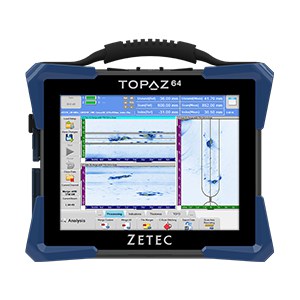Finding the Best Quality Ultrasonic Inspection Equipment for NDT

Finding the best equipment is often easier said than done, as there are so many variables to consider. On a fundamental level, the best ultrasonic inspection equipment should include state-of-the-art software and highly sensitive signal-to-noise ratio (SNR). It should have a simple interface that any NDT analyst can use with ease and be accurate enough to detect even minor, easily-overlooked signs of pitting, cracking, and corrosion.
Phased array ultrasonic testing (PAUT) allows users to maneuver the wave beams and spot minuscule flaws that would have gone unnoticed with conventional NDT scanning. A corrosion scanner, meanwhile, can adapt to the curvature of any object while reading weakened areas with impeccable precision, allowing users to achieve a full scanning radius. As such, a PAUT instrument and an NDT paintbrush scanner are two of the best instruments on the market.
PAUT Functionality
PAUT is most useful when dealing with steel materials and welds that have coarse-grain content. The reflections of each grain cause high noise levels that can derail a more conventional inspection process. The solution to this problem would be a top-notch PAUT instrument with 2D matrix array probes at low-frequency.
When it comes to instrumentation, total focusing method (TFM) and full matrix capture (FMC) are two additional features that can aid in detection. While not every inspection will require them, TFM and FMC capabilities are included in most high-quality instruments as they can achieve an in-depth focus into any flaw in question, with the best instruments permitting up to one million points per frame.
2D Probing: A Closer Look
2D probing used at low-frequency will combat propagation issues caused by the grain materials. It’s versatile in the sense that it can inspect fine-grain materials within the welds using shear waves. However, 2D matrix array probing also produces longitudinal waves that can handle rough grains within austenitic welds.
Example: A level 1 NDT analyst needs to inspect a weld with a high level of coarse-grain content. The supervisor is nowhere to be found, so the analyst is left to inspect on his own. Using PAUT instrument with a 2D matrix array probe, he remembers to lower the frequency anywhere between 1.5 MHz and 3.5 MHz. This procedure allows the analyst to bypass the rough grain levels and obtain a complete scope of the scanning radius in question. Meanwhile, the efficient software powering the instrument provides the data in a digestible manner for the user to read.
In terms of flexibility, PAUT and 2D matrix array afford inspectors the following possibilities:
- Customizing the focus depth
- Customizing the beam direction
- Customizing the beam shape
These customization options permit a more comprehensive probe that covers more ground than other NDT methods. PAUT improves upon standard UT methods by allowing multiple angles within a sole probe. This method also helps companies save time and money, as analysts can complete more inspections with fewer probes, analyzing multiple angles at once with a single probe and scanning large areas with relative ease. The same all-encompassing scanning aptitude is also afforded to the corrosion scanner.
Corrosion Scanning Prowess
A corrosion scanner offers similarly powerful software and comprehensive scanning capabilities. In particular, an NDT paintbrush scanner is adaptable enough for nearly any surface, regardless of its curvature or odd shape. It’s the perfect device for localizing problematic areas found within infrastructure, no matter how minor.
Example: A pipeline company finished inspecting an outdoor pipeline using long-range ultrasonic testing (LRUT). The waves picked up several strange anomalies within various sections of the pipes. In order to get a more complete picture of the damage, an NDT analyst isolates the piping section and applies the paintbrush to one of the pipes. The scanner detects active corrosion found within the pipe, something that the LRUT failed to outline precisely.
In terms of corrosion scanning and wall-thickness measurements, the paintbrush is the best solution available within the NDT UT field due to its powerful software and unrivaled detection probe. The software provides data in real time while allowing online and offline analysis. It provides a full-scale overlay and 3D mapping system that’s easy to read, with all data available instantly. At the same time, the interface and tools are simple and intuitive to use, requiring only basic training to operate and minimal setup time.
Paintbrush scanners are adept at conforming to the shape of tested objects thanks to their encoded wheels. The wheels adapt to the shape or curvature of the test site, allowing the analyst to attain a more detailed image on screen. It’s also one of the best tools for testing unconventional welds, such as composite materials used in the aerospace industry.
The scanner can outline the following anomalies that typically result in wall thinness:
- Erosion
- Abrasion
- Corrosion
Moreover, it provides a precise measurement of the wall thickness, including minute damage that could cause major damage in the long-term.
Choosing the Best Ultrasonic Inspection Equipment
PAUT and corrosion scanning tools achieve more accurate findings when compared to standard NDT equipment. These tools are supported by leading software that provides live data that’s easily-digestible. The best ultrasonic inspection equipment affords enhanced safety and asset longevity.
Additionally, they are most capable of detecting early occurrences that could jeopardize operations in the near future. PAUT and corrosion scanners are the best instruments to use due to the stellar tools that read more flaws than most NDT strategies. The equipment will also help managers and owners stay one step ahead of regulators by addressing flaws and problems before the regulators do.
Zetec provides a comprehensive NDT plan using the latest corrosion scanning and PAUT methods. To learn more about our ultrasonic and eddy current solutions, contact Zetec today.





